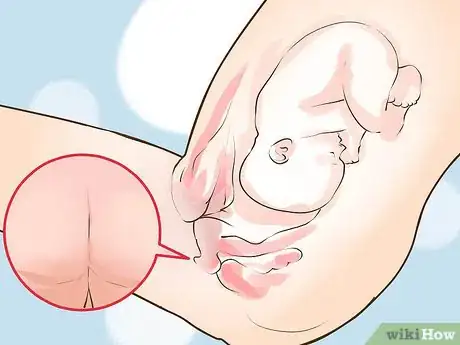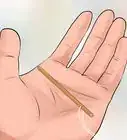This article was co-authored by Jennifer Butt, MD. Jennifer Butt, MD, is a board certified Obstetrician and Gynecologist operating her private practice, Upper East Side OB/GYN, in New York City, New York. She is affiliated with Lenox Hill Hospital. She earned a BA in Biological Studies from Rutgers University and an MD from Rutgers – Robert Wood Johnson Medical School. She then completed her residency in obstetrics and gynecology at Robert Wood Johnson University Hospital. Dr. Butt is board certified by the American Board of Obstetrics and Gynecology. She is a Fellow of the American College of Obstetricians and Gynecologists and a member of the American Medical Association.
There are 12 references cited in this article, which can be found at the bottom of the page.
wikiHow marks an article as reader-approved once it receives enough positive feedback. This article received 18 testimonials and 95% of readers who voted found it helpful, earning it our reader-approved status.
This article has been viewed 1,769,951 times.
Cervical dilation happens as a pregnant woman gets closer to her labor and delivery. The cervix dilates in order to unblock your baby’s path from your uterus to the birth canal, and finally to your arms.[1] The cervix needs to dilate from one to 10 centimeters (3.9 in), at which point you can deliver your baby.[2] In most cases, licensed professionals such as doctors, nurses, and midwives will check to see how far your cervix is dilated, but you also might want to get a sense for yourself. We've done the research for you and included plenty of advice from reputable sources like the American Pregnancy Association and the UK National Health Service.
Steps
Preparing to Check Your Cervix Manually
-
1Talk to your medical professional. Having a safe pregnancy is important to a healthy birth and baby. Making sure you’re getting proper obstetrical care from a doctor, nurse practitioner or midwife can help ensure not only that your pregnancy is progressing normally but also that it’s safe for you to check your cervix for dilation.[3]
- Be aware that beginning in your ninth month of pregnancy, your doctor will begin looking for signs that your labor is getting closer. This includes palpitating your abdomen and performing an internal exam to check your cervix. He or she will see if the baby has “dropped,” which means that the cervix has begun to dilate and get softer.
- Ask your doctor any questions you may have, including if the baby has dropped. You should also ask if it is safe to check dilation on your own. If your pregnancy is safe, then you can proceed.
-
2Wash your hands. Having dirty hands can spread bacteria and germs that cause infection. Checking your cervix requires inserting a hand or fingers into your vagina.[4] It’s imperative to your health and that of your unborn baby to wash your hands before you check your cervix for dilation.[5]
- Use any soap and some warm water to clean your hands. Wet your hands with running water and apply your soap, lathering well. Rub your hands vigorously for at least 20 seconds, making sure to scrub each surface of your hands. Rinse off the soap and then dry your hands thoroughly.
- Use a hand sanitizer of at least 60% alcohol if you don’t have soap. Apply enough of the sanitizer for both hands to the palm of one hand. Just as with soap, rub your hands together and make sure you cover every surface including nails. Keep rubbing until your hands are dry.
Advertisement -
3Reach out for help. If you’re a bit worried or scared about doing the exam on your own, ask your partner or another loved one for help. Allow the person to help as much as you are comfortable with and like. Support can come in the form of holding a mirror or your hand or even offering calming words.
-
4Get into a comfortable position. Before you can effectively check your cervix for dilation, you need to be in a comfortable position. You might want to sit on your toilet or lie on your bed with your legs spread, just do what is most comfortable for you.[6]
- Take off your clothes on your lower half before you start. This way, you don’t have to awkwardly remove them when you’re comfy.
- Sit or squat on the toilet with one foot on the floor and the other on the toilet seat. You can also squat on the floor or lie on your bed if these are more comfortable
- Remember that you have nothing about which to be ashamed. You’re doing something completely normal and natural.
Checking Your Cervix at Home
-
1Insert two fingers into your vagina. You’ll need to start your exam by getting an initial sense of how far you may be dilated. Instead of putting your entire hand into your vagina, which may cause discomfort, use your pointer and middle fingers to start checking your cervix.[7]
- Remember to wash your hands thoroughly with soap and water before inserting your fingers into your vagina.
- Locate the entrance of your vagina with the tips of your fingers. The back of your hand should be facing your spine, and your palm should face upwards. Angle your fingers back towards your anus to most effectively feel your cervix. If you feel any pain or extreme discomfort, remove your fingers.
-
2Push your fingers to your cervix. A woman’s cervix feels like a pair of puckered lips when pregnant. After you’ve inserted your fingers into and up your vaginal canal, keep pushing them until you reach what feels like the puckered lips.[8]
- Be aware that some women have a high cervix and others have a low cervix. You may need to insert your fingers further up your vaginal canal or may reach it relatively quickly. The cervix is basically the “end” of your vaginal canal no matter its position in your body.[9]
- Use a gentle touch to feel for your cervix. Pressing or poking it with your fingers can lead to bleeding.
- Recognize that one finger may easily slip into the middle of your cervix if it is dilating. What you may feel at the center of the opening is your bag of waters that covers the baby’s head. You may find this has the sensation of a latex balloon filled with water.[10]
-
3Continue using your fingers to feel how far you’re dilated. Once a woman is dilated 10 centimeters, she’ll generally ready to deliver her baby. If one of your fingers entered the middle of the cervix easily, you can use additional fingers to figure out how far along your dilation is.[11]
- Keep in mind the following: if you can slip one finger into the middle of your cervix, you’re about one centimeter dilated. Likewise, if you can insert five finger widths into your cervix, you’re about 5 centimeters dilated. As your labor progresses, your cervix will go from feeling tight to like an elastic band. At 5 centimeters, it may feel like and have the thickness of a rubbery circle jar ring used in canning.
- Continue to insert fingers gently into your vagina until you’re using your entire hand or it causes discomfort. Remove your hand to see how many finger widths you used. This can give you a general idea of how far your cervix is dilated.
-
4Go to your delivery center. If you’re cervix is dilated more than 3 centimeters, it generally means you are in the active phase of labor. You should go to the delivery center you’ve chosen or prepare your home if you’re having a home birth.[12]
- Be aware that your contractions can also help indicate that you should go to the delivery center. They will be more regular and stronger. They should be about five minutes apart and last for 45-60 seconds.[13]
Looking for Additional Signs of Cervical Dilation
-
1Listen for the sounds of dilation. There are many indicators of dilation that don’t require inserting your fingers into your vagina. This can be especially helpful if you are in a lot of pain or discomfort. Most women will make some type of sound when they’re in labor. Listening to what types of sounds you’re making can cue you into how much you’re cervix has dilated. The following sounds can accompany the various stages of labor and cervical dilation:[14]
- At 0-4 centimeters dilated, you may not be making much noise and can talk through a contraction with little effort.
- At 4-5 centimeters, it may be difficult to nearly impossible to talk. Your noises may still be quiet.
- Between 5-7 centimeters, you may make louder and staccato noises. It should be nearly or completely impossible to talk through contractions.
- Between 7–10 centimeters (2.8–3.9 in), you may be making very loud noises and shouldn’t be able to talk through a contraction.
- If you’re a silent laborer, you can also check your dilation. Tell someone to ask you a question at the start of a contraction. The less you are able to say a sentence, the farther along your dilation is.
-
2Pay attention to your emotions. Childbirth is an inherently emotional experience for the woman in labor. Watching what emotions you’re experiencing can cue you into how far your cervix is dilated. You may have the following emotions during labor:[15]
- Happiness and laughter between 1-4 centimeters
- Smiley and laughing at little things between contractions between 4-6 centimeters
- Irritation at jokes and small talk around 7 centimeters until birth.
-
3Smell for dilation. Many people will notice certain scents when a woman gets to between 6 and 8 centimeters dilated. The smell of labor is deep, heavy, and dusky—not musky.[16] If you notice a distinct change to these scents in the smell of the room in which you’re laboring, your cervix may be between 6 and 8 centimeters dilated.
-
4Look for blood and mucus. Some women may see a stringy mucus discharge at 39 weeks that is tinged pink or brown with blood.[17] This bloody show may continue through the early stages of labor. At 6-8 centimeters dilated, however, a lot of blood and mucus may be present. Looking for these substances can indicate that you’re somewhere between 6-8 centimeters dilated.
-
5Examine the purple line. The purple line is located in your natal cleft, or what some people call the butt crack. This line can be a measure of how far you’re dilated, with it reaching the top of your cleft at full dilation. You may need someone to help you examine your purple line.[18]
- Recognize that in the early stages of labor that the purple line will be closer to the anus. As your labor progresses, it will creep up between your buttocks. At full dilation, the purple line will extend to the top of your natal cleft.
-
6Scan how your body feels. Many women experience physical signs of dilation that are visible without a vaginal examination. In general, many will feel like they have the flu as they get close to 10cm and/ or the pushing phase. Scanning your body for these signs and symptoms can help you figure out how much your cervix has dilated. In most, cases, a combination of these signs can indicate how you’re your cervix is dilated.[19]
- Feeling like you have to vomit, having a flushed face and feeling warm to the touch can mean you’re about 5 centimeters dilated. You may also tremble uncontrollably. Vomiting alone may be the result of emotions, hormones, or fatigue.
- Seeing if your face is flushed with no other signs can be a good indicator that you’re 6-7 centimeters dilated.
- Be aware that trembling uncontrollably without any other signs can indicate fatigue or fever.
- See if you’re curling your toes or standing on your toes, which is a sign you’re between 6 and 8 centimeters dilated.
- Check your buttocks and upper thighs for goosebumps, which is a good sign that you’re at 9-10 centimeters.
- Recognize that having involuntary bowel movements is also a sign of full dilation.[20] You may also see or feel the head at your perineum.
-
7Feel for pressure in your back. As your baby descends into the birth canal, you will feel pressure at different points along your back. The more you dilate, the farther down your back the pressure will be lower. It will generally move from the rim of your pelvis down to your tailbone.[21]
Expert Q&A
Did you know you can get expert answers for this article?
Unlock expert answers by supporting wikiHow
-
QuestionCan you check your own cervix for dilation?
 Jennifer Butt, MDJennifer Butt, MD, is a board certified Obstetrician and Gynecologist operating her private practice, Upper East Side OB/GYN, in New York City, New York. She is affiliated with Lenox Hill Hospital. She earned a BA in Biological Studies from Rutgers University and an MD from Rutgers – Robert Wood Johnson Medical School. She then completed her residency in obstetrics and gynecology at Robert Wood Johnson University Hospital. Dr. Butt is board certified by the American Board of Obstetrics and Gynecology. She is a Fellow of the American College of Obstetricians and Gynecologists and a member of the American Medical Association.
Jennifer Butt, MDJennifer Butt, MD, is a board certified Obstetrician and Gynecologist operating her private practice, Upper East Side OB/GYN, in New York City, New York. She is affiliated with Lenox Hill Hospital. She earned a BA in Biological Studies from Rutgers University and an MD from Rutgers – Robert Wood Johnson Medical School. She then completed her residency in obstetrics and gynecology at Robert Wood Johnson University Hospital. Dr. Butt is board certified by the American Board of Obstetrics and Gynecology. She is a Fellow of the American College of Obstetricians and Gynecologists and a member of the American Medical Association.
Board Certified Obstetrician & Gynecologist
-
QuestionDoes checking the cervix for dilation hurt?
 Jennifer Butt, MDJennifer Butt, MD, is a board certified Obstetrician and Gynecologist operating her private practice, Upper East Side OB/GYN, in New York City, New York. She is affiliated with Lenox Hill Hospital. She earned a BA in Biological Studies from Rutgers University and an MD from Rutgers – Robert Wood Johnson Medical School. She then completed her residency in obstetrics and gynecology at Robert Wood Johnson University Hospital. Dr. Butt is board certified by the American Board of Obstetrics and Gynecology. She is a Fellow of the American College of Obstetricians and Gynecologists and a member of the American Medical Association.
Jennifer Butt, MDJennifer Butt, MD, is a board certified Obstetrician and Gynecologist operating her private practice, Upper East Side OB/GYN, in New York City, New York. She is affiliated with Lenox Hill Hospital. She earned a BA in Biological Studies from Rutgers University and an MD from Rutgers – Robert Wood Johnson Medical School. She then completed her residency in obstetrics and gynecology at Robert Wood Johnson University Hospital. Dr. Butt is board certified by the American Board of Obstetrics and Gynecology. She is a Fellow of the American College of Obstetricians and Gynecologists and a member of the American Medical Association.
Board Certified Obstetrician & Gynecologist
Warnings
References
- ↑ http://www.whattoexpect.com/pregnancy/symptoms-and-solutions/dilation-and-effacement.aspx
- ↑ http://americanpregnancy.org/labor-and-birth/first-stage-of-labor/
- ↑ Jennifer Butt, MD. Board Certified Obstetrician & Gynecologist. Expert Interview. 13 March 2020.
- ↑ Jennifer Butt, MD. Board Certified Obstetrician & Gynecologist. Expert Interview. 13 March 2020.
- ↑ http://www.mayoclinic.org/healthy-lifestyle/adult-health/in-depth/hand-washing/art-20046253
- ↑ http://www.gentlebirth.org/archives/birth.html#Self-Checking
- ↑ http://www.gentlebirth.org/archives/birth.html#Self-Checking
- ↑ http://www.gentlebirth.org/archives/birth.html#Self-Checking
- ↑ https://www.verywell.com/how-to-check-your-cervix-and-cervical-position-1960299
- ↑ http://www.gentlebirth.org/archives/birth.html#Self-Checking
- ↑ http://www.gentlebirth.org/archives/birth.html#Self-Checking
- ↑ Jennifer Butt, MD. Board Certified Obstetrician & Gynecologist. Expert Interview. 13 March 2020.
- ↑ http://www.nhs.uk/conditions/pregnancy-and-baby/pages/hospital-birth-centre-labour.aspx
- ↑ https://sarahvine.wordpress.com/2010/03/07/how-dilated-am-i-assessing-dilation-without-an-internal-exam/
- ↑ https://sarahvine.wordpress.com/2010/03/07/how-dilated-am-i-assessing-dilation-without-an-internal-exam/
- ↑ https://sarahvine.wordpress.com/2010/03/07/how-dilated-am-i-assessing-dilation-without-an-internal-exam/
- ↑ http://www.whattoexpect.com/pregnancy/bloody-show
- ↑ http://www.ncbi.nlm.nih.gov/pubmed/20846387
- ↑ http://www.sheknows.com/parenting/articles/834969/tips-for-the-first-stage-of-labor
- ↑ http://www.gentlebirth.org/archives/birth.html#Self-Checking
- ↑ https://sarahvine.wordpress.com/2010/03/07/how-dilated-am-i-assessing-dilation-without-an-internal-exam/
About This Article
To check your cervix for dilation, start by washing your hands to avoid spreading any bacteria. Then take off your pants and get comfortable sitting down or lying with your legs spread. If you’re worried about doing the exam on your own, ask your partner or another loved one to help. When you’re ready to check your cervix, start by inserting 2 fingers into your vagina and feeling for your cervix. When you reach your cervix, which feels like a pair of puckered lips, measure the opening with your fingers. If your cervix is dilated more than 3 centimeters, which is about the width of 3 fingers, you should go to the delivery center, since this generally means you’ve started the active phase of labor. For more tips, including how to check your cervix for other signs of dilation, read on!











































































Medical Disclaimer
The content of this article is not intended to be a substitute for professional medical advice, examination, diagnosis, or treatment. You should always contact your doctor or other qualified healthcare professional before starting, changing, or stopping any kind of health treatment.
Read More...